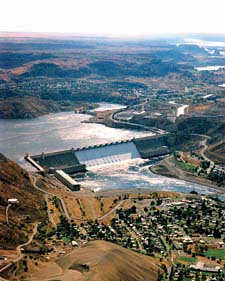Watching Utilities

Today, the facility, like most hydroelectric dams, nuclear power plants and other major utilities, faces a different kind of threat: domestic and international terrorism, in which the infrastructure is a potential target.
The U.S. government now spends significant dollars on ways to better protect such plants as well as on research and development of new security solutions. Between the U.S. Department of Homeland Security and the White House’s Homeland Security Council, an estimated $40 billion is earmarked to local, state and federal security endeavors this year, with another $7 billion aimed at anti-terrorism research.
Dam the security
The U.S. Bureau of Reclamation manages the Grand Coulee Dam and its complementary Columbia Basin Project. An agency of the Department of the Interior, the Bureau contracted just months ago with the U.S. Army Corps of Engineers for a $4 million upgrade of the dam’s integrated security system that blends video surveillance, intrusion detection, electronic access control and communications subsystems.Adesta, a multi-discipline infrastructure service provider and integrator with headquarters in Omaha, will install and upgrade the integrated systems. In addition to the Corps, Adesta security clients have included the FBI, U.S. military facilities, the California National Guard and the Smithsonian Institution, yet the dam still represents a daunting assignment for the company.
The United States has 75,000 dams nationwide, but according to Federal Emergency Management Administration Director Joe Allbaugh, “There are approximately 10,000 dams in the U.S. whose failure, from any cause, including a terrorist attack, could result in loss of life, significant property damage, disruption of critical facilities and environmental damage.”
Return to Three Mile Island
Another type of utility that's a terror target is the power generation plant, especially nuclear power plants.The General Accounting Office, an independent auditing and investigative arm of Congress, faulted the Nuclear Regulatory Commission last year, citing inadequate security. But various sites, operated by local power companies, have spent considerable money upgrading security at their facilities. Some also have showcased their renewed security efforts to dampen criticism of too little protection.
The nuclear facility on Three Mile Island (TMI) was made famous by surviving a core meltdown in 1979. Today, the site contains a top-of-the-line security system that was shown off during a press tour offered by TMI Manager of Security Michael Bruecks and Hugh McNally, Mid-Atlantic region manager of nuclear security for TMI co-owner Exelon Energy.
TMI now boasts a strong safety record but, largely due to its past notoriety, the island remains a key target of terrorism. Most recently, there is speculation that Spanish-based Islamic terrorists sent e-mails about the facility.
Among security upgrades, there now are more armed guards at the main gates, with TMI’s private security force often augmented with National Guard troops and state police officers. The latter two can carry automatic weapons and guards are authorized to shoot to kill.
Visitor parking is located at least 200 yards from the nearest building. All vehicles are checked for explosives. Much like the perimeter of a prison, there are two sensor-equipped fences around the TMI facility. Guards search plant workers and authorized visitors through metal and explosive detection systems. Access to the facility is controlled by a combination of electronic cards and biometrics.
TMI also is in the midst of an upgrade of an extensive array of outdoor sirens as part of its emergency warning system. They are placed in the area surrounding the facility.
To be completed this summer, TMI officials will add 14 new sirens and replace six sirens with more powerful equipment. At the end of the upgrade, there will be 93 sirens within ten miles of Three Mile Island. The first siren was installed in 1982 and the array is complemented with routing of emergency messages through first responders, local television and radio stations.
The acoustical capacity of the siren system, at the end of the retrofit process, will increase by about 20 percent. TMI officials said that, while the existing system covered a required 10-mile radius, increases in the population and changes such as vegetation growth, increased traffic and new roads and structures underlined the need to boost the siren sound level.
Over the past two years, TMI security installed new computer monitoring gear, new siren electronic communications equipment and new communications radio and receivers at county dispatch centers. These and the siren upgrades will cost about three-quarters of a million dollars.
Still, nuclear plants remain somewhat vulnerable to other extreme attacks. Very large truck bombs could, some suggest, create an earthquake-like effect that may break apart pipes inside a plant. Security specialists also are concerned about the threat posed by airplanes – hijacked or simply malfunctioning. There is an ongoing controversy related to the extent of damage to a facility from an airliner crashing into the structure, given all the more significance by the Sept. 11 terrorist attacks.
Yet major facilities like Three Mile Island and the Grand Coulee Dam are committed to focusing money and manpower to combat terrorist threats that are now all too real.
Sidebar: Power Plant Security Checklist
The American Public Power Association recently published a Security Checklist and Guidance Manual for mid- to small-sized power generation and distribution utilities. The manual also provides valuable information for other types of facilities. It includes a means to self-evaluate a facility as well as provide case studies. Security magazine readers can obtain information on or order a copy of the $60 publication by visiting www.appanet.org/publications.Sidebar: Outlining the Grand Coulee
- Hydroelectric dam
- Irrigation help
- Largest U.S. concrete structure
- Third-largest worldwide hydroelectric facility
Sidebar: Upgrading Dam Security
- Video surveillance
- Intrusion detection
- Electronic access control
- Security communications
Sidebar: Upgrading TMI Security
- More armed guards
- Remote visitor parking
- Metal, explosives detection
- Two concurrent perimeter systems
- Louder sirens within ten miles
- Better communications with county dispatch centers
Looking for a reprint of this article?
From high-res PDFs to custom plaques, order your copy today!





